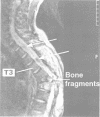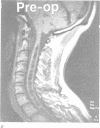Abstract
OBJECTIVES--To assess the incidence of post-traumatic syringomyelia (PTS), to correlate the presence of PTS with its most common signs and symptoms, and to compare results from the Swiss Paraplegic Centre with those reported in the medical literature. METHODS--A total of 449 recent traumatic paraplegic and tetraplegic patients admitted to the Swiss Paraplegic Centre in Zurich between 1 January 1987 and 31 December 1993 were prospectively analysed. Yearly clinical tests with conventional radiographs and additional T1 and T2 weighted images were performed as soon as PTS was diagnosed. RESULTS--Of these 449 patients 20 patients displayed symptoms of PTS (4.45%). Ten non-operated patients remained clinically stable (average time: 37 months). Ten worsened--three refused operation, seven were operated on. Mean worsening time was 97 months. Deterioration was closely related to the enlargement of the cyst whereas in operated patients neurological improvement or stabilisation correlated with collapse of the cyst. CONCLUSIONS--Delay between appearance of the first symptoms of PTS and deterioration making surgery necessary may be long (mean five years in the seven operated patients) underlining the need for regular tests. "Slosh" and "suck" mechanisms could explain cyst enlargement as surgical realignment of the spine resulted in a complete cyst collapse in two of the operated patients (normalisation of CSF flow? ). Cord compression, tense syrinx at the fracture site, and kyphosis seemed to be closely linked to the enlargement of the cyst with subsequent further neurological deterioration.
Full text
PDF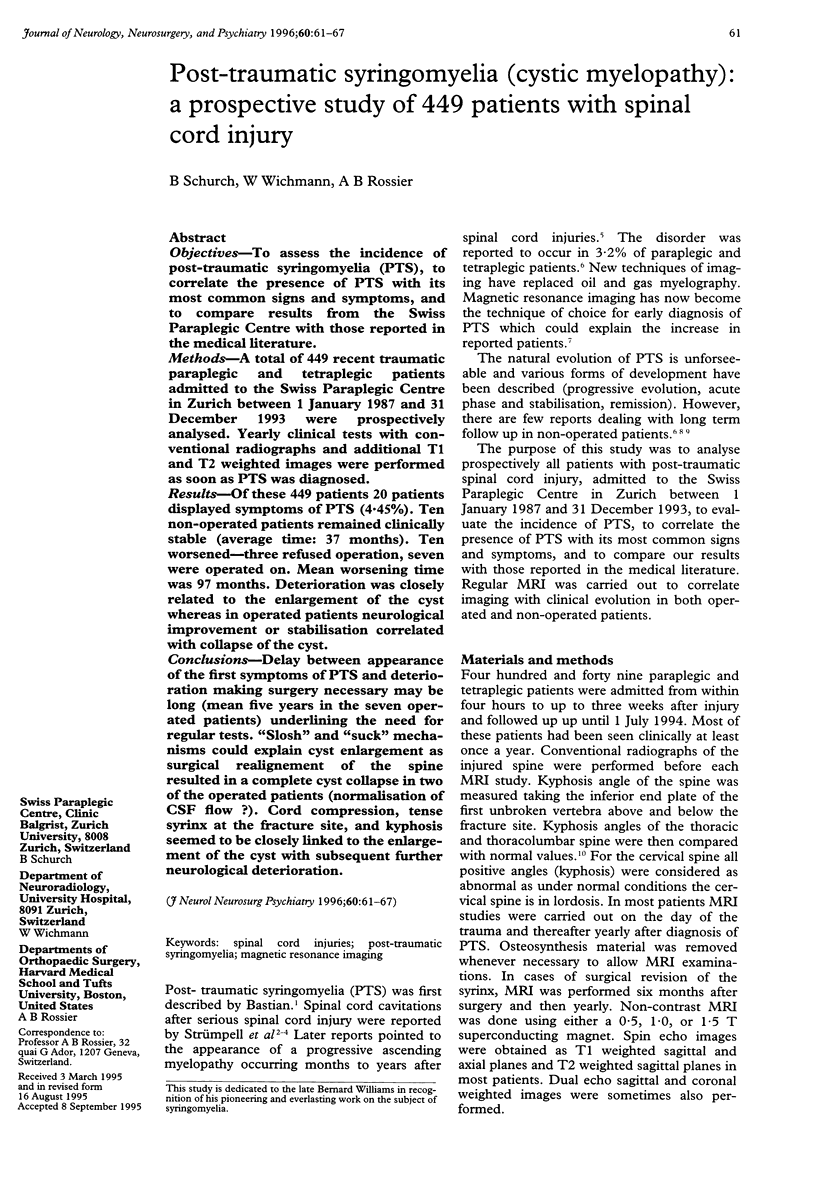
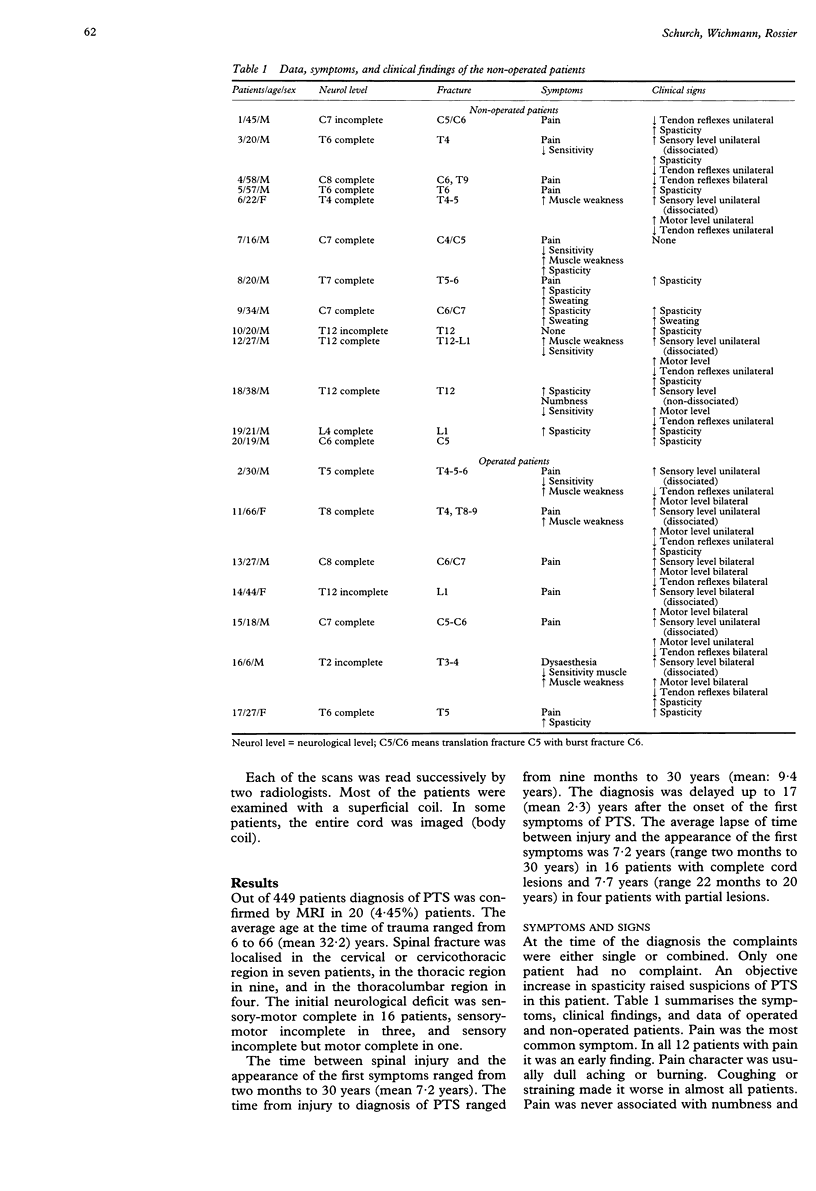
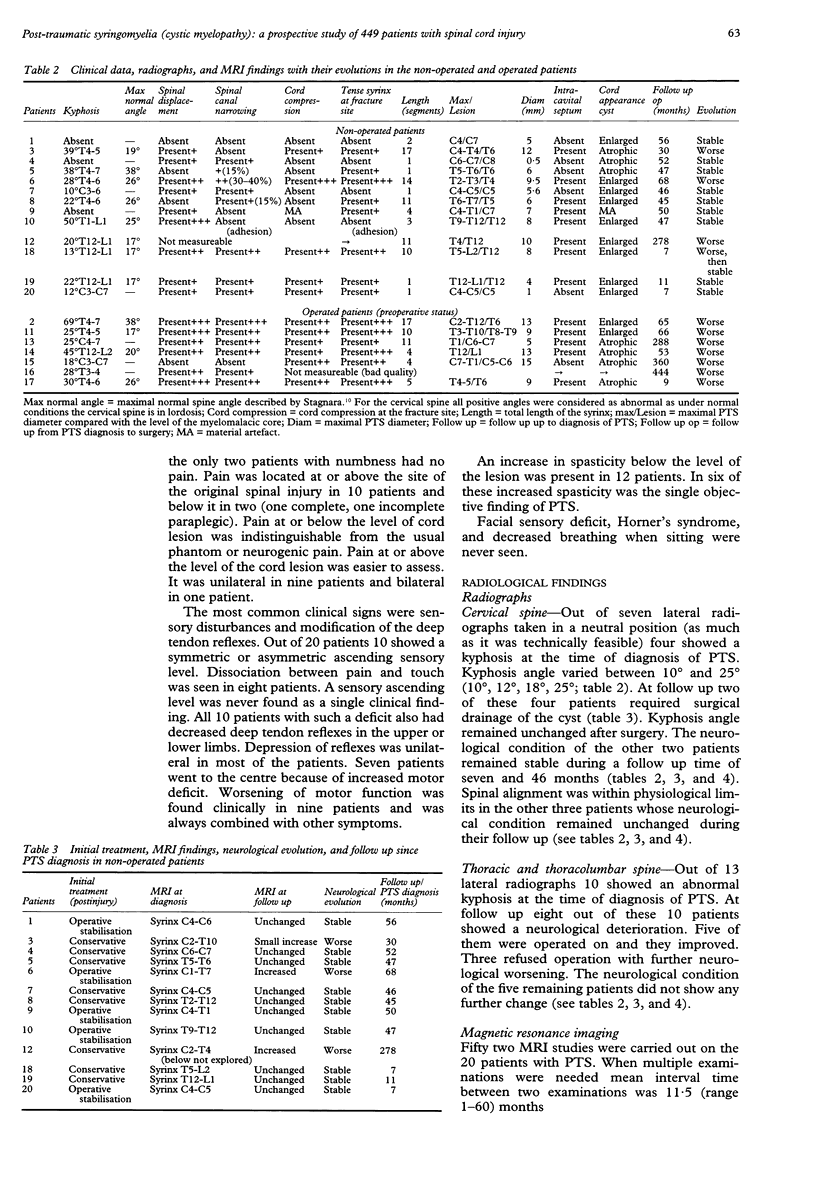
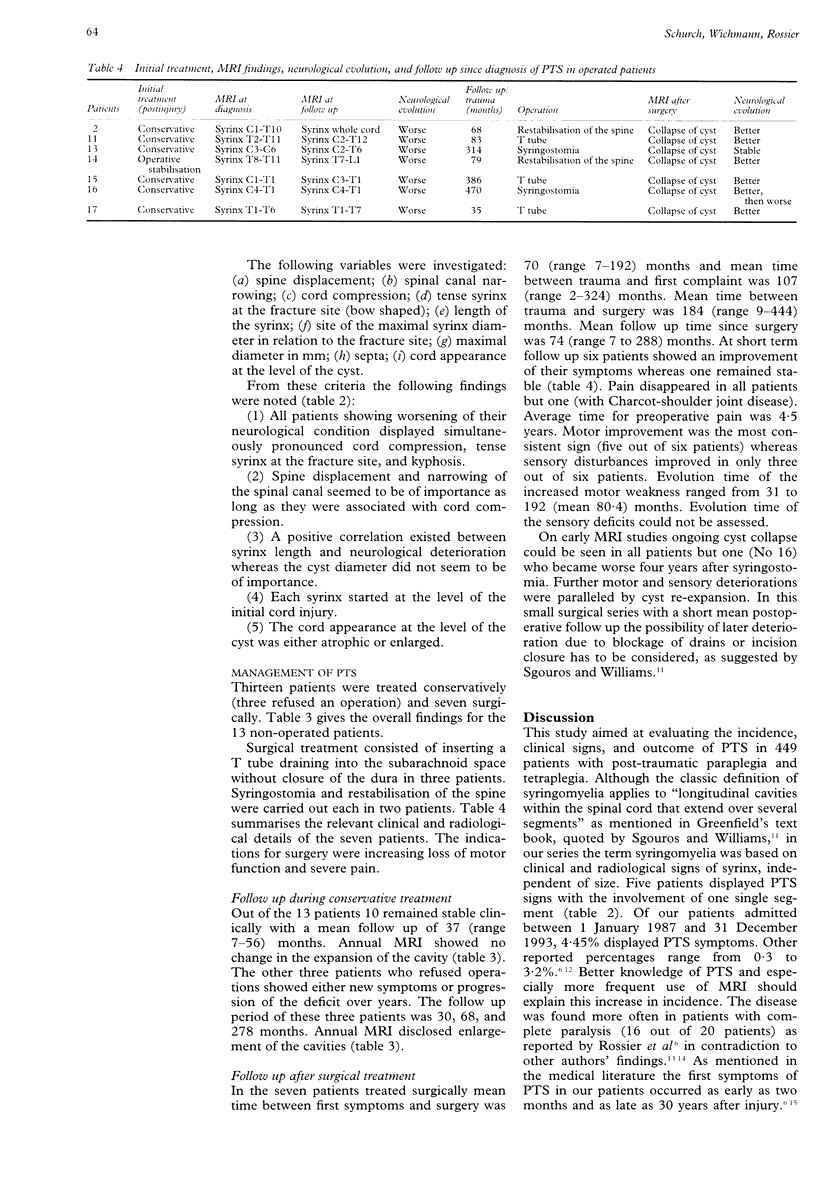
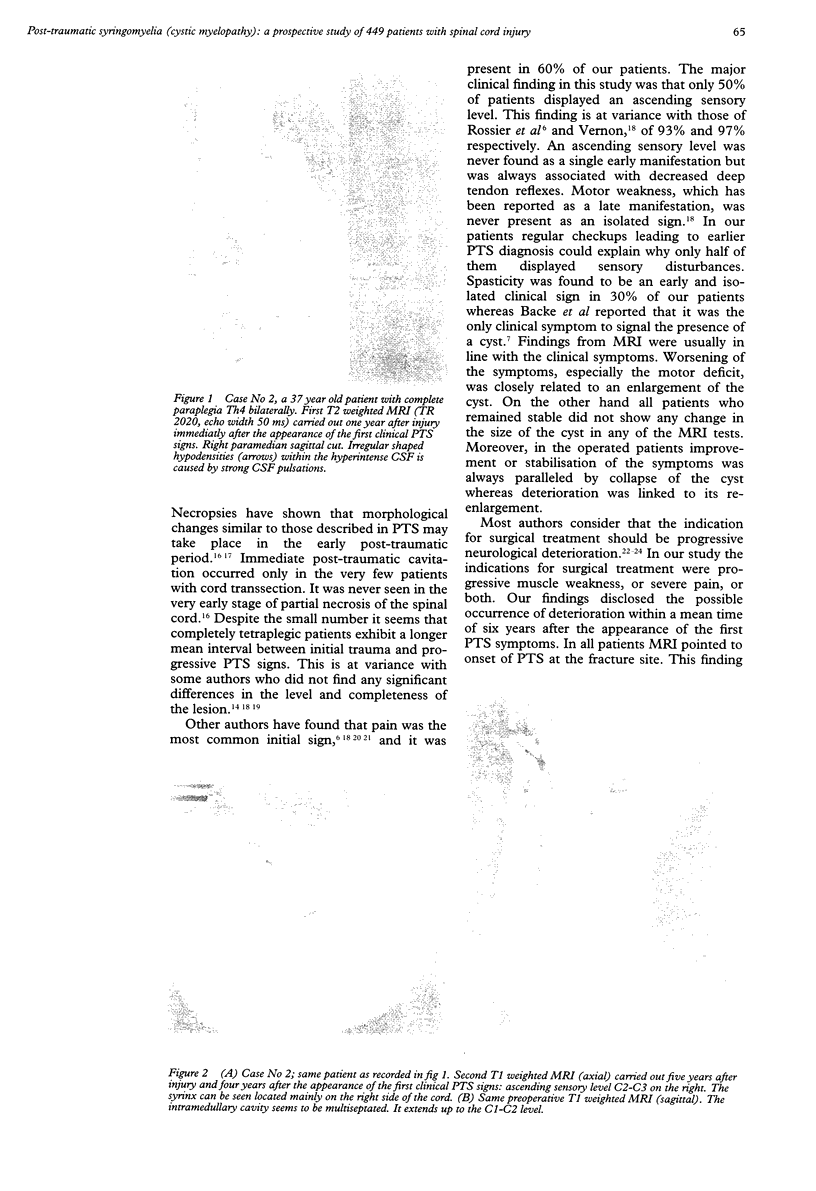

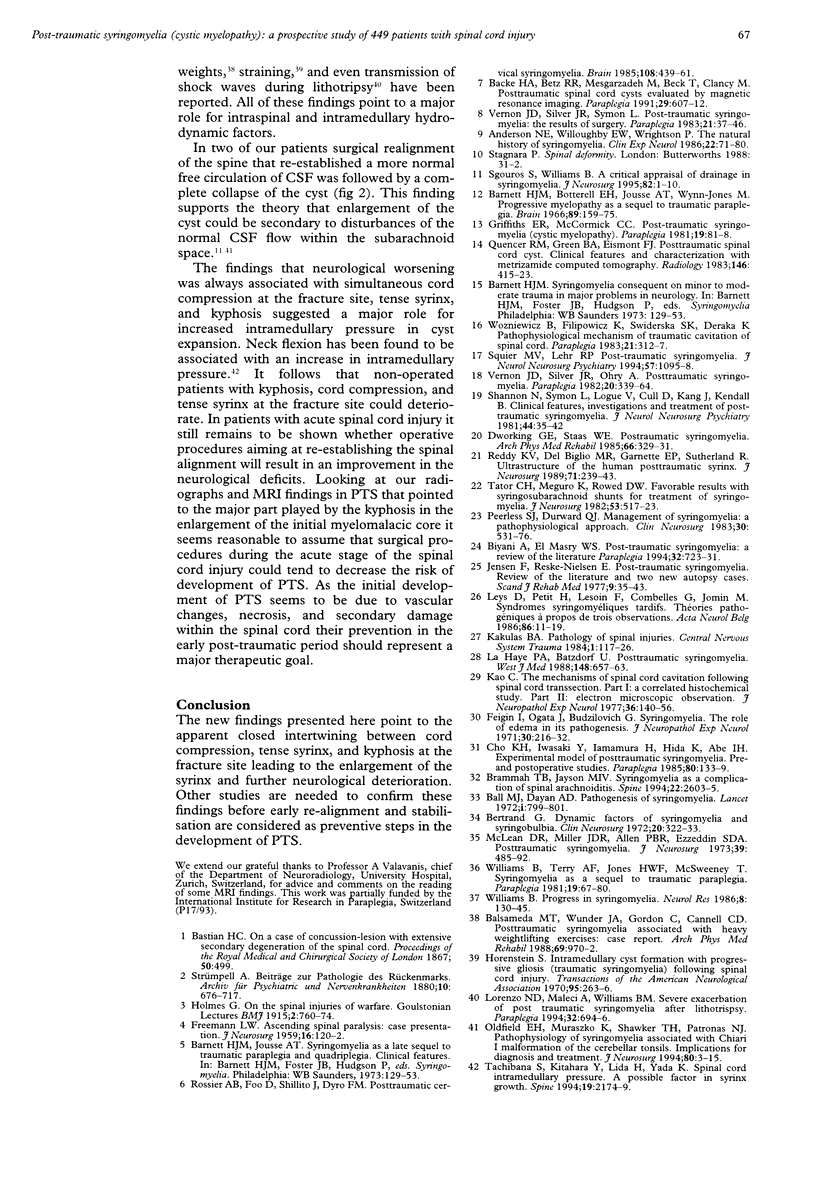
Images in this article
Selected References
These references are in PubMed. This may not be the complete list of references from this article.
- Anderson N. E., Willoughby E. W., Wrightson P. The natural history of syringomyelia. Clin Exp Neurol. 1986;22:71–80. [PubMed] [Google Scholar]
- Backe H. A., Betz R. R., Mesgarzadeh M., Beck T., Clancy M. Post-traumatic spinal cord cysts evaluated by magnetic resonance imaging. Paraplegia. 1991 Nov;29(9):607–612. doi: 10.1038/sc.1991.89. [DOI] [PubMed] [Google Scholar]
- Ball M. J., Dayan A. D. Pathogenesis of syringomyelia. Lancet. 1972 Oct 14;2(7781):799–801. doi: 10.1016/s0140-6736(72)92152-6. [DOI] [PubMed] [Google Scholar]
- Balmaseda M. T., Jr, Wunder J. A., Gordon C., Cannell C. D. Posttraumatic syringomyelia associated with heavy weightlifting exercises: case report. Arch Phys Med Rehabil. 1988 Nov;69(11):970–972. [PubMed] [Google Scholar]
- Barnett H. J., Botterell E. H., Jousse A. T., Wynn-Jones M. Progressive myelopathy as a sequel to traumatic paraplegia. Brain. 1966 Mar;89(1):159–174. doi: 10.1093/brain/89.1.159. [DOI] [PubMed] [Google Scholar]
- Bertrand G. Chapter 26. Dynamic factors in the evolution of syringomyelia and syringobulbia. Clin Neurosurg. 1973;20:322–333. doi: 10.1093/neurosurgery/20.cn_suppl_1.322. [DOI] [PubMed] [Google Scholar]
- Biyani A., el Masry W. S. Post-traumatic syringomyelia: a review of the literature. Paraplegia. 1994 Nov;32(11):723–731. doi: 10.1038/sc.1994.117. [DOI] [PubMed] [Google Scholar]
- Brammah T. B., Jayson M. I. Syringomyelia as a complication of spinal arachnoiditis. Spine (Phila Pa 1976) 1994 Nov 15;19(22):2603–2605. doi: 10.1097/00007632-199411001-00019. [DOI] [PubMed] [Google Scholar]
- Di Lorenzo N., Maleci A., Williams B. M. Severe exacerbation of post traumatic syringomyelia after lithotripsy. Case report. Paraplegia. 1994 Oct;32(10):694–696. doi: 10.1038/sc.1994.112. [DOI] [PubMed] [Google Scholar]
- Dworkin G. E., Staas W. E., Jr Posttraumatic syringomyelia. Arch Phys Med Rehabil. 1985 May;66(5):329–331. [PubMed] [Google Scholar]
- FREEMAN L. W. Ascending spinal paralysis; case presentation. J Neurosurg. 1959 Jan;16(1):120–122. doi: 10.3171/jns.1959.16.1.0120. [DOI] [PubMed] [Google Scholar]
- Griffiths E. R., McCormick C. C. Post-traumatic syringomyelia (cystic myelopathy). Paraplegia. 1981;19(2):81–88. doi: 10.1038/sc.1981.19. [DOI] [PubMed] [Google Scholar]
- Horenstein S. Intramedullary cyst formation with progressive gliosis (traumatic syringomyelia) following spinal cord injury. Trans Am Neurol Assoc. 1970;95:263–266. [PubMed] [Google Scholar]
- Jensen F., Reske-Nielsen E. Post-traumatic syringomyelia. Review of the literature and two new autopsy cases. Scand J Rehabil Med. 1977;9(1):35–43. [PubMed] [Google Scholar]
- Kakulas B. A. Pathology of spinal injuries. Cent Nerv Syst Trauma. 1984 Winter;1(2):117–129. doi: 10.1089/cns.1984.1.117. [DOI] [PubMed] [Google Scholar]
- Kao C. C., Chang L. W., Bloodworth J. M., Jr Electron microscopic observations of the mechanisms of terminal club formation in transected spinal cord axons. J Neuropathol Exp Neurol. 1977 Jan;36(1):140–156. doi: 10.1097/00005072-197701000-00012. [DOI] [PubMed] [Google Scholar]
- La Haye P. A., Batzdorf U. Posttraumatic syringomyelia. West J Med. 1988 Jun;148(6):657–663. [PMC free article] [PubMed] [Google Scholar]
- Leys D., Petit H., Lesoin F., Combelles G., Jomin M. Syndromes syringomyéliques post-traumatiques tardifs. Théories pathogéniques à propos de trois observations. Acta Neurol Belg. 1986 Jan-Feb;86(1):11–19. [PubMed] [Google Scholar]
- McLean D. R., Miller J. D., Allen P. B., Ezzeddin S. A. Posttraumatic syringomyelia. J Neurosurg. 1973 Oct;39(4):485–492. doi: 10.3171/jns.1973.39.4.0485. [DOI] [PubMed] [Google Scholar]
- Oldfield E. H., Muraszko K., Shawker T. H., Patronas N. J. Pathophysiology of syringomyelia associated with Chiari I malformation of the cerebellar tonsils. Implications for diagnosis and treatment. J Neurosurg. 1994 Jan;80(1):3–15. doi: 10.3171/jns.1994.80.1.0003. [DOI] [PubMed] [Google Scholar]
- Peerless S. J., Durward Q. J. Management of syringomyelia: a pathophysiological approach. Clin Neurosurg. 1983;30:531–576. doi: 10.1093/neurosurgery/30.cn_suppl_1.531. [DOI] [PubMed] [Google Scholar]
- Quencer R. M., Green B. A., Eismont F. J. Posttraumatic spinal cord cysts: clinical features and characterization with metrizamide computed tomography. Radiology. 1983 Feb;146(2):415–423. doi: 10.1148/radiology.146.2.6849087. [DOI] [PubMed] [Google Scholar]
- Reddy K. K., Del Bigio M. R., Sutherland G. R. Ultrastructure of the human posttraumatic syrinx. J Neurosurg. 1989 Aug;71(2):239–243. doi: 10.3171/jns.1989.71.2.0239. [DOI] [PubMed] [Google Scholar]
- Rossier A. B., Foo D., Shillito J., Dyro F. M. Posttraumatic cervical syringomyelia. Incidence, clinical presentation, electrophysiological studies, syrinx protein and results of conservative and operative treatment. Brain. 1985 Jun;108(Pt 2):439–461. doi: 10.1093/brain/108.2.439. [DOI] [PubMed] [Google Scholar]
- Sgouros S., Williams B. A critical appraisal of drainage in syringomyelia. J Neurosurg. 1995 Jan;82(1):1–10. doi: 10.3171/jns.1995.82.1.0001. [DOI] [PubMed] [Google Scholar]
- Shannon N., Symon L., Logue V., Cull D., Kang J., Kendall B. Clinical features, investigation and treatment of post-traumatic syringomyelia. J Neurol Neurosurg Psychiatry. 1981 Jan;44(1):35–42. doi: 10.1136/jnnp.44.1.35. [DOI] [PMC free article] [PubMed] [Google Scholar]
- Squier M. V., Lehr R. P. Post-traumatic syringomyelia. J Neurol Neurosurg Psychiatry. 1994 Sep;57(9):1095–1098. doi: 10.1136/jnnp.57.9.1095. [DOI] [PMC free article] [PubMed] [Google Scholar]
- Tachibana S., Kitahara Y., Iida H., Yada K. Spinal cord intramedullary pressure. A possible factor in syrinx growth. Spine (Phila Pa 1976) 1994 Oct 1;19(19):2174–2179. [PubMed] [Google Scholar]
- Tator C. H., Meguro K., Rowed D. W. Favorable results with syringosubarachnoid shunts for treatment of syringomyelia. J Neurosurg. 1982 Apr;56(4):517–523. doi: 10.3171/jns.1982.56.4.0517. [DOI] [PubMed] [Google Scholar]
- Vernon J. D., Silver J. R., Ohry A. Post-traumatic syringomyelia. Paraplegia. 1982 Dec;20(6):339–364. doi: 10.1038/sc.1982.64. [DOI] [PubMed] [Google Scholar]
- Vernon J. D., Silver J. R., Symon L. Post-traumatic syringomyelia: the results of surgery. Paraplegia. 1983 Feb;21(1):37–46. doi: 10.1038/sc.1983.6. [DOI] [PubMed] [Google Scholar]
- Williams B. Progress in syringomyelia. Neurol Res. 1986 Sep;8(3):130–145. doi: 10.1080/01616412.1986.11739745. [DOI] [PubMed] [Google Scholar]
- Williams B., Terry A. F., Jones F., McSweeney T. Syringomyelia as a sequel to traumatic paraplegia. Paraplegia. 1981;19(2):67–80. doi: 10.1038/sc.1981.18. [DOI] [PubMed] [Google Scholar]
- Wozniewicz B., Filipowicz K., Swiderska S. K., Deraka K. Pathophysiological mechanism of traumatic cavitation of the spinal cord. Paraplegia. 1983 Oct;21(5):312–317. doi: 10.1038/sc.1983.52. [DOI] [PubMed] [Google Scholar]



